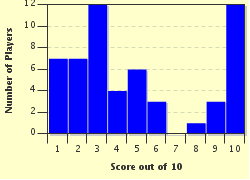Quiz Answer Key and Fun Facts
1. How many different space lattices are there?
2. In the tetragonal crystal structure such as that seen in the neodymium-iron-boron magnet, all angles are 90 degrees. But what are the sides like?
3. In a crystal structure only 4 types of symmetry can be found. these are?
4. Which one of these is NOT a crystal defect?
5. Which of these relaxes stress in a crystal?
6. Although crystals are rarely perfect some come pretty close and others not. Which of these structures would be the least crystalline?
7. In a nuclear reactor the overheating of the graphite rods is caused by the coming together of two defects. These are?
8. Which one of these is not one of the 7 crystal types?
9. What is unique about a triclinic crystal structure?
10. What are the movements in crystals that are the main carriers of heat called?
Source: Author
inigohowe
This quiz was reviewed by FunTrivia editor
WesleyCrusher before going online.
Any errors found in FunTrivia content are routinely corrected through our feedback system.

